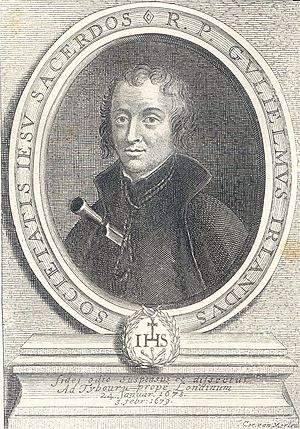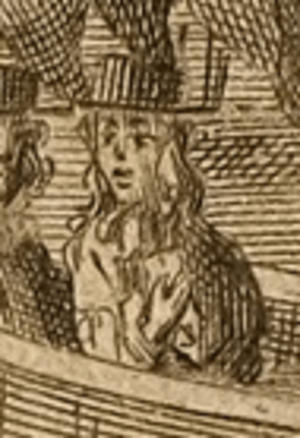William Ireland (Jesuit) facts for kids
Quick facts for kids BlessedWilliam Ireland SJ |
|
|---|---|
 |
|
| Martyr | |
| Born | c.1636 Lincolnshire, England |
| Died | 24 January 1679 (aged 42–43) Tyburn, London, England |
| Honored in | Roman Catholic Church |
| Beatified | 15 December 1929, Rome by Pope Pius XI |
| Feast | 24 January |
William Ireland (born 1636, died 1679) was an English Jesuit priest. He was a member of the Jesuits, a group of Catholic priests. William is remembered as a martyr, meaning he died for his religious beliefs. He was wrongly accused of planning to kill King Charles II during a time of great fear called the Popish Plot. He was executed on January 24, 1679. In 1929, Pope Pius XI declared him "Blessed," and his feast day is celebrated every year on January 24.
Contents
William Ireland's Early Life
William Ireland was born in Lincolnshire, England, in 1636. He had several sisters who worked very hard to prove he was innocent later in his life.
William went to school at the English College at St. Omer. When he was 19, he joined the Society of Jesus in 1655. He then studied to become a priest in Liege and was ordained in 1667. For a few years, he worked as a confessor (a priest who hears confessions) for a group of nuns called the Poor Clares in Gravelines.
The Popish Plot
In 1677, William Ireland was sent to England to work for the Jesuits there. On September 28, 1678, he was arrested by police officers. They were led by Titus Oates, a man who made up a big story called the Popish Plot. This plot claimed that Catholics were planning to kill the King.
William was taken before the Privy Council, a group of the King's advisors. Other people arrested with him included John Grove, who was a lay brother (a non-priest member of a religious order).
False Accusations
Titus Oates and another man named William Bedloe claimed that William Ireland and John Grove had planned to kill King Charles II. They said this meeting happened on August 19 in the rooms of another Jesuit, William Harcourt. The plan, they claimed, was to assassinate the King at Newmarket.
Oates and Bedloe's stories convinced the jury, even though these two men were not known for being honest. The judge, William Scroggs, also spoke against Ireland.
Proving Innocence
William Ireland had a strong alibi, which meant he could prove he was somewhere else when the crime was supposedly planned. His sisters also showed a lot of evidence that Oates and Bedloe were not trustworthy. Despite this, William was found guilty.
Imprisonment and Execution
After being found guilty, William Ireland was held in Newgate Prison. He was sentenced to death on December 17. While in prison, William wrote a journal. In it, he explained where he had been almost every day between August 3 and September 14. This journal, along with witnesses like Mrs. Jane Harwell, who said William stayed at her house during that time, caused a lot of trouble for the judges.
Even King Charles II said he wasn't sure if the evidence against Ireland was true. He thought it might even be false. However, a servant girl named Sarah Paine claimed she saw Ireland in Fetter Lane on August 20. Because of this, the judges decided that William's alibi was not true.
| Blessed John Grove |
|
|---|---|

Detail of a Popish Plot card drawn by Francis Barlow
|
|
| Martyr | |
| Died | 24 January 1679 Tyburn, London, England |
| Beatified | 15 December 1929 by Pope Pius XI |
| Feast | 24 January |
Final Moments
After being delayed twice, William Ireland and John Grove were executed together at Tyburn. John Grove said, "We are innocent, we lose our lives wrongfully, we pray God to forgive them that are the causes of it."
The King, who privately believed they were innocent, showed them a special kindness. He ordered that they be allowed to hang until they were dead. This spared them from the more brutal parts of the usual execution method of drawing and quartering.
After the Execution
Later, more false claims were made against William Ireland. However, the false evidence that Oates gave against Ireland became very important. When Oates was later tried for perjury (lying under oath) in 1685, the court focused on his lies about Ireland.
This was unusual and might show that King Charles II (who died just before Oates's trial) strongly believed Ireland was innocent. The government may have felt bad about rejecting William Ireland's very strong alibi. This alibi had been discussed twice by the Privy Council and was a key reason Oates was found guilty at his own trial.

